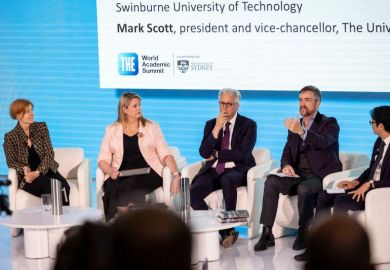Browse the full results of the World University Rankings 2025
Higher education has always been a sector with a broad span of age groups, from fresh-faced students to ageing professors who continue researching way past retirement age. But now there are more people in the older age groups – part of a wider shift of people working for longer in many countries – while a move towards lifelong learning means older learners in the student group, too.
There are now five generations present in the broader workplace, and leaders in many sectors are turning their attention to harnessing the experience and talents of a workforce with a widening age span. How does this apply to universities?
“Academia is probably a place where we have long respected and valued tenure as a concept and tenure in terms of length of time, but there is an interesting shift going on,” says Meghan Gerhardt, author of Gentelligence and professor of management and leadership at Miami University.
“It used to be that if you wanted expertise or a high level of knowledge, the people that held that were professors, researchers and the people who write encyclopedias,” she says.
“Twenty years ago, suddenly, everything turned upside down. And my students today, I would say, don’t necessarily need me for information; they can get information in five seconds. Our role as professors has changed from fount of knowledge to ‘let me help you understand how to make sense of that information’.”
Gerhardt’s research into what students expect from faculty shows that older learners value expertise, whereas younger ones are drawn to professors with whom they connect. “That has changed the game in higher education. I think there are people who have been there a long time who are not very happy about the fact that ‘gatekeeper of knowledge’ is no longer the role.”
She emphasises that there must be two-way learning between professors and students now, especially as technology is changing so rapidly. But it is also the professor’s role to prepare students for the broadly different views of people in the workplace who will soon be their managers.
“Gen Z is the first generation that’s broken down mental health stigma. So they’re talking much more openly about mental health, which is amazing,” Gerhardt says. However, while the university campus is now used to that change, the average workplace might not be, and a challenge is how to prepare students for that different context, she believes.
Leaders must also be aware of the changing demographics of students. As the need for upskilling grows, teaching learners of different ages will become ever more important.
Christopher Dede, senior research fellow at the Harvard Graduate School of Education, says some believe that the developmental differences between a 25-year-old and a 55-year-old are as profound as the differences between a five- and a 10-year-old.
“I’m going to teach something to this 55-year-old with a lot of life experience, but who is perhaps less agile in their thinking than they were when they were 20. How is that different from teaching the same thing to the 20-year-old with a little life experience and a lot of agility? If you personalise those, the teaching strategies should be quite different from one another, even if the educational goals are the same,” he says.
While Gerhardt uses the concept of generations, other academics debate the usefulness of labels such as Gen Z, millennials and boomers. Largely originating with the US thinktank the Pew Research Center, there are no globally agreed dates for their beginning, and end and some argue they promote unhelpful stereotypes.
“In so many domains of life, we’re told not to have stereotypes, but then we’re talking about generations and we do it with aplomb,” says Dan Cable, professor of organisational behaviour at London Business School.
However, Cable says there are broad differences in what people want from work, depending on their age group. He has noted a shift from workers seeking a clear upward trajectory and opportunities for promotion to a desire for meaningful work, learning and passion; the last is strongest among the youngest workers. What does this mean for higher education?
Cable believes that a construct he teaches called “freedom within the frame” is a useful way to consider that question. The frame is “what the job has to deliver. It’s why the organisation would pay somebody to have the job, and it’s not really negotiable. But the freedom is how you do the work, [and] that can often be full of experimentation and trying new ways,” he says.
Most academics have such freedom, but university leaders could seek to apply the concept to non-academic staff, Cable adds.
Jennifer Deal, a senior research scientist at the Center for Effective Organizations at the University of Southern California, says that, bar one exception, she has seen no notable difference between generations when it comes to workplace behaviour. For Deal, the life stage of a person and their role in an organisation can tell an employer more about their needs and how they will behave in the workplace than their age group. For example, there is a stereotype that younger employees work fewer hours. But younger employees in more senior roles tend to work more hours, she says.
To support employees, she suggests, university managers should consider their life stage, which she defines as: young and single; in a relationship; with children; and with carer responsibilities for older relatives.
Deal has studied workplace age-related conflict and says it often comes down to power and who gets to make the rules. Those in authority, who tend to be older, believe they should make the rules. Younger workers can believe they are “more in touch” and therefore they should make the rules. “All these perspectives are fundamentally about power and people’s desire for power: everybody of all different generations jockeying to increase the power that they have to control the world that they’re in.”
One way to solve this in universities and other institutions, according to Deal, is to pay attention to decision rights. “Oftentimes, an organisation’s decision rights are abysmally unclear because they want everybody to have input into the decision, which is lovely, but that often makes for even more conflict,” she says. If 10 people have a say in a decision that only two people have a stake or expertise in, conflict will arise, she adds. “Good decision rights really help reduce conflict, because then people are clear. Then what you’re doing is having the power conflict about who gets to make the decision.”
Daniel Jolles, a behavioural scientist at the Inclusion Initiative at the London School of Economics and Political Science, believes that “there are a lot of barriers preventing organisations from getting the productivity benefits of age diversity and a multigenerational workplace”.
His research, based on private organisations, has found that there are tensions between younger and older employees, but that intergenerationally inclusive workplaces outperform, and their staff have higher job satisfaction and are more productive.
Being an age-inclusive workplace involves three things, Jolles says: having managers who appreciate intergenerational diversity and have the skills to lead intergenerational teams; developing and promoting people based on merit rather than age; and having a culture that makes it easy for people of all ages to fit in.
He points out that while being older might not hinder academic staff, many older staff on the administration side, especially in technical roles, could be held back by their age because of stereotyping. “We want to make sure that we’re giving a fair go to younger academics and older non-academic staff,” he says.
Even those who believe that there is usually no discernible difference between generations agree that one factor is relevant: people who grew up with smartphones have poorer mental health. It may be that supporting the mental health of the university workforce, as well as students, will be the main challenge for university leaders.
Register to continue
Why register?
- Registration is free and only takes a moment
- Once registered, you can read 3 articles a month
- Sign up for our newsletter
Subscribe
Or subscribe for unlimited access to:
- Unlimited access to news, views, insights & reviews
- Digital editions
- Digital access to THE’s university and college rankings analysis
Already registered or a current subscriber?








